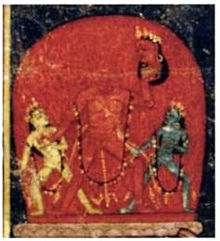
Guanyin is a Bodhisattva associated with compassion. She is the East Asian representation of Avalokiteśvara and has been adopted by other Eastern religions including Chinese folk religion. She was first given the appellation of "Goddess of Mercy" or "Mercy Goddess" by Jesuit missionaries in China. Guanyin is short for Guanshiyin, which means "[The One Who] Perceives the Sounds of the World." On the 19th day of the sixth lunar month, Guanyin's attainment of Buddhahood is celebrated.

Tantra are the esoteric traditions of Hinduism and Buddhism that developed in India from the middle of the 1st millennium CE onwards. The term tantra, in the Indian traditions, also means any systematic broadly applicable "text, theory, system, method, instrument, technique or practice". A key feature of these traditions is the use of mantras, and thus they are commonly referred to as Mantramārga in Hinduism or Mantrayāna and Guhyamantra in Buddhism.
Prithvi or Prithvi Mata 'the Vast One' is the Sanskrit name for the earth as well as the name of a devi (goddess) in Hinduism and some branches of Buddhism. In the Vedas, her consort is Dyaus Pita, the sky god but, later in Puranas, she is known as Bhūmi, Varaha's wife.

Lakshmi, also known as Shri, is one of the principal goddesses in Hinduism. She is the goddess of wealth, fortune, power, beauty, fertility and prosperity, and associated with Maya ("Illusion"). Along with Parvati and Saraswati, she forms the Tridevi of Hindu goddesses.

In Japanese religion, Yahata formerly in Shinto and later commonly known as Hachiman is the syncretic divinity of archery and war, incorporating elements from both Shinto and Buddhism.
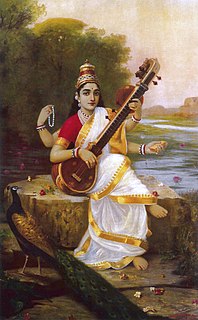
Saraswati is the Hindu goddess of knowledge, music, art, speech, wisdom, and learning. She is one of the Tridevi, along with the goddesses Lakshmi and Parvati.

Benzaiten, also simply known as Benten, is a Japanese Buddhist goddess who originated mainly from Saraswati, the Hindu goddess of speech, the arts, and learning, with certain traits deriving from the warrior goddess Durga. Worship of Benzaiten arrived in Japan during the sixth through eighth centuries, mainly via Classical Chinese translations of the Golden Light Sutra, which has a section devoted to her.

In Hinduism, the goddess Tara is the second of the Dasa (ten) Mahavidyas or "Great Wisdom goddesses", and is a form of Adishakti, the tantric manifestation of Parvati. Her most famous centre of worship is the temple and the cremation ground of Tarapith in West Bengal, India. Her three most famous forms are Ekajaṭā, Ugratara, and Nīlasarasvatī.

Kisshōten, also known as Kichijōten, Kisshoutennyo (吉祥天女), Kudokuten (功徳天) is a Japanese female deity, adapted via Buddhism from the Hindu goddess Lakshmi. Kisshoutennyo is sometimes named as one of the Seven Gods of Fortune (fukujin), replacing either Jurōjin or Fukurokuju. For example, in the 1783 edition of the Butsuzōzui compendium, Kichijōten replaces Fukurokuju as one of the seven fukujin. She is considered to be the goddess of happiness, fertility, and beauty. Kisshoutennyo's iconography is distinguished by the Nyoihōju gem (如意宝珠) in her hand, Kisshōten and the Nyoihōju gem are both represented by the symbol of the kagome.

Tara, Ārya Tārā, or Shayama Tara, also known as Jetsun Dölma is an important figure in Buddhism, especially revered in Tibetan Buddhism. She appears as a female bodhisattva in Mahayana Buddhism, and as a female Buddha in Vajrayana Buddhism. She is known as the "mother of liberation", and represents the virtues of success in work and achievements. She is known as Duōluó Púsà (多羅菩薩) in Chinese Buddhism, and as Tara Bosatsu (多羅菩薩) in Japan.

The Kek Lok Si Temple is a Buddhist temple situated in Air Itam, Penang, Malaysia. It is the largest Buddhist temple in Malaysia, and is also an important pilgrimage centre for Buddhists from Hong Kong, the Philippines, Singapore and other countries in Southeast Asia. The entire complex of temples was built over a period from 1890 to 1930, an inspirational initiative of Beow Lean, the abbot. The main draw in the complex is the striking seven-storey Pagoda of the late Thai king Rama VI, which structure is known as the pagoda of Ten Thousand Buddhas with 10,000 alabaster and bronze statues of Buddha, and the 36.57-metre-tall (120 ft) bronze statue of Guanyin, the Goddess of Mercy. The 10.000 Buddhas concept belongs to the Chinese Mahāyāna school of Buddhism while Rama VI was king over a Theravāda country and Buddhist tradition.

Mārīcī, is a Buddhist god (devi) or goddess, as well as a bodhisattva associated with light and the Sun. By most historical accounts, Marici is a goddess, but in some regions, she is depicted as a male god, revered among the warrior class in East Asia. She is typically depicted with multiple arms and riding a charging boar or sow, or on a fiery chariot pulled by seven horses or seven boars. She has either one head, or between three to six with one shaped like a boar. In parts of East Asia, in her fiercest forms, she may wear a necklace of skulls. In some representations, she sits upon a lotus.
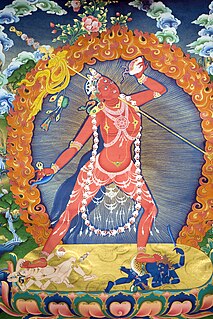
Vajrayoginī is a Tantric Buddhist female Buddha and a ḍākiṇī. The Vajrayogini cult dates back to the tenth and twelfth centuries. Vajrayoginī's essence is "great passion" (maharaga), a transcendent passion that is free of selfishness and illusion—she intensely works for the well-being of others and for the destruction of ego clinging. She is seen as being ideally suited for people with strong passions, providing the way to transform those passions into enlightened virtues.

Munneswaram temple is an important regional Hindu temple complex in Sri Lanka. It has been in existence at least since 1000 CE although myths surrounding the temple associate it with the popular Indian epic Ramayana, and its legendary hero-king Rama. The temple is one of the ancient Pancha Ishwarams dedicated to Shiva in the region.

Gajalakshmi, also spelt as Gajalaxmi, is one of the most significant Ashtalakshmi aspects of the Hindu goddess of prosperity, Lakshmi.
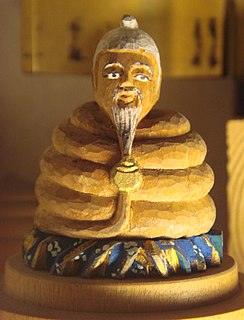
Ugajin (宇賀神) is harvest and fertility kami of Japanese Mythology. Ugajin is represented both as a male and a female, and is often depicted with the body of a snake and the head of a bearded man, for the masculine variant, or the head of a woman, for the female variant. In Tendai Buddhism Ugajin was syncretically fused with Buddhist goddess Benzaiten, which became known as Uga Benzaiten or Uga Benten. The goddess sometimes carries on her head Ugajin's effigy.

The Goddess Ugratara is the tutelary deity of Eastern Ganga dynasty kings of erstwhile Kalinga dynasty. Her ancient temple lies at Mulajharigarh village, Bhusandapur 65 kilometers from State capital Bhubaneswar, Odisha, India. The icon of Mother Tara is three-eyed and Chaturbhuja, holding potent weapons as sword, dagger, blue lotus and a drinking cup in her hands. She stands over a corpse on burning flames of funeral pyre. Serpent anklets and a serpent on crown are visible which clearly dates back to the time of the 11th-century Tantrik text Sadhanamala Tantra. When later kings of Gajapati dynasty revered goddess Kali or Shyamakaali she had less importance and her worship received less attention. But many people belonging to Vasishtha Gotra revere her as Ishta devi. She is one among ten Mahavidya in Hindu Tantrik theology. She is very popular as Ugratara due to her fierce aspect, but benevolent to the adorers as Ekajata/Neela-Saraswati. Nearby railway station is Bhushandapur in Khordha district which is accessible from Bhubaneswar and Balugaon by local passenger trains. The main festivals here are Chaitra parba, Raja Parba, Sharadiya Durga Puja. She is worshipped in tantrik way and offered all tantrik fivefold paraphrenalias.
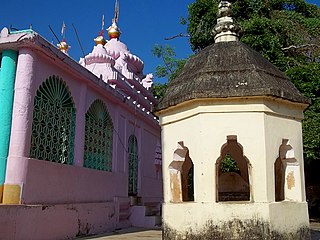
Marichi Temple is a Hindu and Buddhist temple located in Ajodhya, Baleswar, Odisha, India.
Maṇimēkalai, also spelled Manimekhalai or Manimekalai, is a Tamil-Buddhist epic composed by Kulavāṇikaṉ Seethalai Sataṉar probably around the 6th century. It is an "anti-love story", a sequel to the "love story" in the earliest Tamil epic Silappadikaram, with some characters from it and their next generation. The epic consists of 4,861 lines in akaval meter, arranged in 30 cantos.

Mekhala "The Elder Severed-Headed Sister" and Kanakhala "The Younger Severed-Headed Sister") are two sisters who figure in the eighty-four mahasiddhas of Vajrayana Buddhism. Both are described as the disciples of another mahasiddha, Kanhapa (Krishnacharya). They are said to have severed their heads and offered them to their guru, and then danced headless. Their legend is closely associated with the Buddhist severed-headed goddess Chinnamunda.
